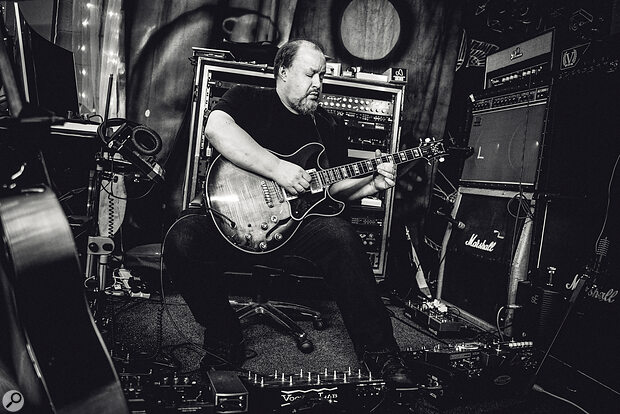Guitarist Steve Rothery is the longest‑serving member of prog‑rockers Marillion, and has developed side projects including a solo album and a folk‑fused project under the name of the Wishing Tree. His guitar playing is also featured on albums by Steve Hackett, Arena and Swallow The Sun to name but a few. Here, he details how he got his favourite guitar sound on Marillion’s ‘The Great Escape’.
 “While there is only one guitar sound on this track, it actually morphs into five different tones. Using my Japanese Squier Stratocaster fitted with EMG SA pickups and a Kahler locking tremolo, it starts out with a slightly grungey Marshall tone courtesy of a Marshall JCM800 50 Watt amp. Then in the second section, I switch to using Rockman modules into an Alesis QuadraVerb and a Roland JC‑120. It’s a very clean, bright, compressed sound with delay and reverb, which gives a very sort of spacious sound.
“While there is only one guitar sound on this track, it actually morphs into five different tones. Using my Japanese Squier Stratocaster fitted with EMG SA pickups and a Kahler locking tremolo, it starts out with a slightly grungey Marshall tone courtesy of a Marshall JCM800 50 Watt amp. Then in the second section, I switch to using Rockman modules into an Alesis QuadraVerb and a Roland JC‑120. It’s a very clean, bright, compressed sound with delay and reverb, which gives a very sort of spacious sound.
“It then segues into my signature solo sound that I was using during that period of time, which is a modified Boss DS‑1 through, again, the JC‑120. Because the JC‑120 is a transistor amp, it’s got a very clean, bright, present sound. Another tonal switch occurs next, this time it’s just a rackmounted Boss CE‑300 chorus unit, through the JC‑120 yet again, which is followed into the ending section of the song by the addition of a Leslie speaker, which adds a kind of fast warble to the little play‑out melody that I do in that section. I used a Switchblade switching system and two TC 2290s to switch pedals and delay levels, so all the patch changes were played live.”
Steve Rothery: The room that we were playing in had suits of armour and all sorts of weird stuff like that.
Going South
“My guitar sound for this track was recorded at Miles Copeland’s Château de Marouatte in the South of France, which was an amazing place. It hadn’t been used as a studio before when we went there. So, we had all these kinds of cables and wiring going through the battlements and the master bedroom was a kind of control room. We stuck an SM57 on my guitar amps. I don’t think we used any big condensers in those days. It was quite a surreal environment to record. The room that we were playing in had suits of armour and all sorts of weird stuff like that. So, a lot of it affected the acoustics, and definitely affected the vibe. My amp was in another room down the corridor and on quite loud, which I think you have to be in that situation to get the amp singing. I don’t like compression at the mix stage, as the Boss DS‑1 compresses the sound in a very specific way for the solo sound and the Rockman modules have a compressor built in them.”

